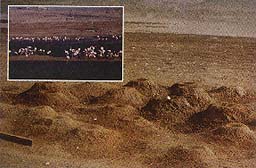First Time Breeding In The UAE
Text and pictures by Peter Hellyer
Peter Hellyer, Managing Editor of Emirates News and a former chairman of the Emirates Natural History Society, tells the story, exclusively for readers of Arabian Wildlife.
The Al Ghar Lakes form annually after rainfall on a large area of inland sabkha salt-flats, in an area that was, until early 1992, also fed by occasional discharge from a nearby sewage treatment-plant. Depending upon the amount of winter rain, the lakes can cover an area of several hectares in the middle of otherwise largely barren dunes, and gradually reduce in size during the course of the summer months, nearly disappearing in some autumns. The construction of embankments across the sabkha in order to allow access to nearby government facilities and the construction of a road has helped in recent years to ensure that at least some of the water remains.
 Greater flamingos have for many years been recorded wintering in shallow lagoons and creeks along the UAE's Arabian Gulf coast, with numbers of up to 800 being seen in Khor Dubai, and lesser numbers of a hundred or more at Ramtha, in Sharjah, Abu Dhabi and the western island of Sir Bani Yas. Believed from occasional recoveries of ringed adults and immatures to come from colonies in northern Iran and the Caspian Sea, their numbers decline during summer, although some birds have been recorded in all months of the year.
Greater flamingos have for many years been recorded wintering in shallow lagoons and creeks along the UAE's Arabian Gulf coast, with numbers of up to 800 being seen in Khor Dubai, and lesser numbers of a hundred or more at Ramtha, in Sharjah, Abu Dhabi and the western island of Sir Bani Yas. Believed from occasional recoveries of ringed adults and immatures to come from colonies in northern Iran and the Caspian Sea, their numbers decline during summer, although some birds have been recorded in all months of the year.
The species was first seen in the Al Ghar Lakes in March 1990, and, apart from a temporary disappearance caused by the virtual drying up of the main lake in late 1992, varying numbers have been seen throughout this period. Until the summer of 1993, however, there had been no apparent attempt at breeding. At the beginning of June, however, ornithologists from the Emirates Natural History Group and the National Avian Research Centre noticed an incipient colony of flamingos on a small island in one of the sabkha lakes, which upon closer inspection, proved to contain several birds sitting on eggs and others building nests.
Over the course of the next month, the size of the colony grew, with up to 22 nest mounds being used by incubating birds, and a total of nearly eighty mounds completed or being built. Although non-breeding birds, which at one time totalled around 500, moved away to another lake as water-levels fell around the breeding island, connecting it with the rest of the 'dry' sabkha, the incubating birds continued to sit, and the first two chicks were seen on July 5th, confirming breeding.
Unfortunately a few days later, the colony was found deserted, with only one dead chick and one abandoned egg being seen when the site was closely inspected. The presence of human footprints suggested that nest-robbing might have occurred, although the falling water levels, coupled with the earlier move of non-breeding birds to a deeper lake nearby prior to the colony's desertion, indicated that other factors may have contributed.
Initial investigations suggested that the birds may have been feeding on midge larvae, common in the lakes, although brine shrimp have been found in other UAE sabkha lakes, and may also have been present at this one.
Ornithologists from the National Avian Research Centre suggested, subsequent to the colony's desertion, that the Al Ghar area could be managed with relative ease to provide a permanent supply of water in an attempt to encourage greater flamingos to nest again during 1994, and plans are being drawn up with the UAE's new Federal Environmental Agency, to see whether the site can be given proper protection and if it can be designated as a national park.
Besides flamingos the Al Ghar Lakes also hold substantial numbers of breeding Kentish plovers (Charadrius alexandrinus), as well as up to two hundred pairs of black-winged stilts (Himantopus himantopus) the largest breeding site known anywhere in Arabia. Nearby, the fodder fields at the Al Wathba Camel Track and a sewage outlet stream, also attract large numbers of migrant waders and passerines, including the UAE's (and Arabia's) first buff-bellied pipit, Anthius japonicus.
Consideration is being given to management of the whole area as one of the UAE's prime birding sites.
Arabian Wildlife. Volume 1, Number 1